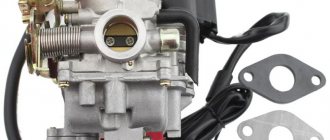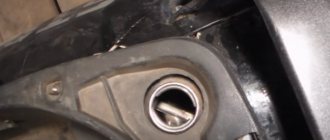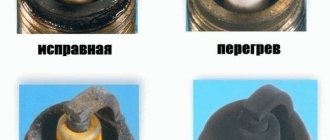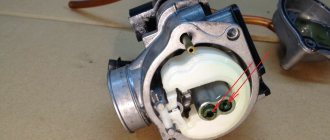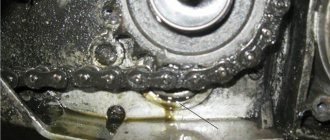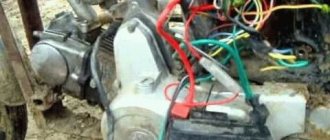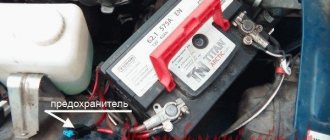Very often on various forums people ask questions like “Why does my moped stall and won’t start?”, and often receive a bunch of advice on what needs to be replaced, even advice to change the moped to a “cooler” one. In fact, even a technically untrained person can diagnose the main engine malfunctions. Let's sort it out in order.
So, for stable operation of the engine, three conditions are needed:
- A good spark on the spark plug electrodes, at the right moment.
- The presence of the “correct” working mixture in the combustion chamber.
- The presence of “compression”, that is, a working cylinder-piston pair and properly functioning valves.
You don't need to be an experienced mechanic or have a bunch of expensive tools to diagnose your moped. Let's look at simple methods for finding a fault.
Visual inspection
You should always check using the “from simple to complex” . If the moped was working like a clock just yesterday, but today it refuses to start, remember what happened to it during this period of time. Maybe you made changes to the electrical circuit, or adjusted the carburetor, or washed the moped, or did some other work - sometimes this helps to localize the fault. If possible, return everything back.
Before starting the test, carefully inspect the moped. You may notice a torn or exposed wire or some other small thing. Sometimes this helps a lot.
Checking the presence of a spark and the condition of the spark plug
This is the simplest check that every moped owner can carry out, having only a spark plug wrench or a spare spark plug on hand. Moreover, if you unscrew the spark plug from the engine, you can at the same time assess its condition and understand by the color of the carbon deposits how correct the working mixture is being prepared by the carburetor.
So, if you unscrew the spark plug from the engine, pay attention to the carbon deposits that cover the central electrode. The carbon deposits should be brown or light brown in color. If the carbon deposits are black, this indicates that the mixture is too rich, or the spark plug is faulty, or the engine is “eating” oil. Perhaps this is the reason for poor engine performance.
Also pay attention to the presence of liquid on the candle. If the spark plug is “wet”, that is, there is gasoline on the spark plug, then gasoline still enters the combustion chamber, but does not ignite. There are at least three reasons why a spark plug may be wet:
- trying to start the engine with the ignition turned off - if you turn the engine with the kick starter for a long time, the spark plug will simply flood with fuel and it will not be able to work normally. To solve the problem, the candle needs to be dried, for example, heated with a lighter.
- The spark plug is faulty - if the spark plug insulation is broken or the gap is broken, the spark plug will not work normally. Only replacing the spark plug with a known good one will help here.
- ignition system faulty
Now we put the tip on the spark plug and press it to a metal surface, for example, to the engine head, turn on the ignition and turn the engine with the kickstarter. It is more convenient to check the spark together, so that one person holds the spark plug and the other turns the engine. But in principle, one person can handle it. Be careful - there is high voltage at the center electrode of the spark plug.
If there is no spark, then the ignition system is at fault. Check all wires for breaks or shorts to ground. All electrical wiring connectors must be connected. If possible, replace the ignition coil with a known good one. Check if the generator coils are damaged. You can read more in the article “The moped has lost its spark, what should I do?”
If you can’t figure out the wiring, contact someone who knows how to do it.
If there is a spark, then most likely the problem is in the power system. Screw the candle into place and continue.
Gasoline supply
If the faucet flows fuel normally, check to see if sediment has accumulated in the carburetor float chamber. Open the drain hole, drain the contents, close it, and try to start the engine again.
To find out whether gasoline is entering the combustion chamber itself, you will need a spark plug wrench. Remove the armor wire from the spark plug, open the tap and operate the starter, then unscrew the spark plug and inspect the insulator. If it is dry, there is a problem with the fuel supply. A wet spark plug will need to be dried before screwing it back in.
Checking the engine power system
First of all, you need to make sure that there is enough gasoline in the gas tank. There is a small tube inside the gas tank that takes gasoline not from the bottom of the gas tank, but a little higher. Therefore, it may turn out that there is still gasoline in the tank, but it does not flow into the carburetor. Therefore, if possible, add gasoline to at least half the tank and try to start the moped again. Perhaps this is the reason.
You also need to know that the gas tap of the Alpha moped has two positions: in one, it takes gasoline closer to the bottom of the gas tank, and in the other, a little higher. If you don’t know in which position the gas tap is open, try installing it in a different position, maybe this will help.
It is very convenient to check the gasoline supply if you have a transparent tube from the gas tank to the carburetor, or have a replaceable gas filter installed. In this case, you can immediately see whether there is gasoline or not.
There is also another simple check of the power system: take a small amount (5-10 ml) of gasoline into a syringe, remove the air intake tube from the carburetor and pour gasoline directly into the carburetor. If after this the moped starts up, or as they say “catch,” then the reason is definitely in the gasoline supply and you need to check the fuel supply and carburetor.
If after all the described checks the problem is not found, there is one more check left - checking the engine compression.
Fuel quality
Normal operation of the internal combustion engine depends on the quality of gasoline. Moreover, when “hot” the engine is less susceptible to this factor, but “when cold” it may not start at all.
If your motorcycle does not start after a recent refueling, you may have been given poor quality fuel. If you refueled from a canister, condensation, rust particles or sand could get into the tank along with gasoline.
To correct the situation, drain low-quality gasoline from the fuel tank and carburetor. With injection engines it is more difficult - in order to drain fuel from the tank, you may have to remove the fuel module. This way, low-quality fuel will not pass through the pump and fine filter.
If you don't know how to get to the spark plugs or carburetor, don't torture yourself and your motorcycle in vain. Contact the professionals: call a field service specialist or call a motorcycle tow truck.
We measure compression
Compression is the pressure in the cylinder at the end of the compression stroke. The magnitude of this pressure allows you to assess the condition of the engine. A working Alpha moped engine should have a compression of at least 8-10 kg/cm² (“atmospheres”) . If it is less, then the engine is faulty: either the piston rings are worn out or the valves are leaking. Most likely the engine will need to be disassembled.
Compression is measured using a compression meter - a special pressure gauge that is inserted or screwed in (depending on the design) instead of the spark plug.
Before measuring compression, it is advisable to warm up the engine, but if it does not start, you will have to measure it cold. It is also advisable to unscrew the carburetor or open the throttle valve and turn off the fuel supply.
The engine must be rotated using an electric starter or kickstarter until the compression meter readings stop increasing.
When the compression is less than 8 atmospheres , you need to pour 10-15 ml of engine oil into the spark plug hole using a syringe. If after this the compression increases noticeably, it means the piston rings are worn out . If not, then the problem is in the valves or camshaft drive . The most common reason: the camshaft drive chain is broken or has slipped, or the valves are bent/broken.
Quick diagnostics
Since in the future the problem of popping noises in the muffler can lead to breakdown of the engine and other important components of the motorcycle, it needs to be solved as quickly as possible. You should consistently check the performance of systems such as: intake, ignition, exhaust. All damaged parts are replaced with new ones, connections are sealed. It is also better to temporarily replace tuning components with “stock” ones to check how the engine will perform with factory settings. If all else fails, the motorcycle should be inspected by a professional mechanic, who will find the cause and tell you how to eliminate it at minimal cost and without reducing the life of the power unit.
Checking the ignition timing
If there is a spark, fuel is supplied, compression is fine, but the moped still does not start - the ignition timing may be off.
On 139fmb engines, which are installed on alpha, the ignition timing is not adjustable. It is rigidly determined by the position of the flywheel on the crankshaft. The engine crankshaft on the generator side has a conical surface on which the flywheel (also known as the generator rotor) is tightly seated. The correct position of the flywheel is set using a key that is inserted into the crankshaft keyway.
You can check this visually (remove the generator cover, unscrew the nut securing the flywheel and see if the grooves match). But the groove on the crankshaft cannot always be seen (depending on the specific instance), so there is a more reliable way: buy or borrow a strobe light from someone (many car repair shops have one), unscrew the plug on the generator cover and check that flashes occur at the same time the label || appears in the window.
The motorcycle shoots into the muffler: why does this happen and how to solve the problem?
On domestic motorcycles, a problem often arises associated with the appearance of loud sounds in the muffler. Even drivers of foreign vehicles often suffer from “machine gun bursts” that accompany a sharp increase or decrease in speed. Getting rid of this trouble can be quite difficult. However, if you understand why a motorcycle shoots its muffler, you can eliminate loud noises that disturb public peace.
If the moped is not
Sometimes it happens that the moped does not want to start after several hours of inactivity. However, after warming up, it works and starts stably. Let's figure out why this happens.
When the engine is cold, all clearances (in the piston, in the valves, etc.) are far from ideal. Plus, when fuel gets on cold engine parts, it evaporates worse and therefore ignites worse. Because of this, during a cold start the engine needs a richer mixture than usual. It is for this purpose that devices are made on carburetor engines to enrich the mixture at start-up.
On the Alpha moped (and similar ones), an air damper is installed. It reduces the air flow and thereby enriches the working mixture. The damper has two positions: “closed” - the lever is raised up, “open” - the lever is lowered down. When starting “on a cold” air damper must be closed (lift the lever up) . When the engine runs for a while with the throttle closed, it needs to be opened. Driving with the throttle closed will lead to increased fuel consumption and the formation of carbon deposits on the spark plug and piston.
What to do if a cold moped does not start even with the throttle closed? Try using a syringe to fill in 5-7 ml. gasoline directly into the carburetor inlet pipe. If the moped starts after this, then the carburetor needs to be adjusted. If it doesn’t start, check the spark and compression (see above).
Carburetor problems
So, you are the owner of a Minsk motorcycle, the carburetor of which regularly receives gasoline, and the spark plug provides a spark sufficient for stable operation of the engine.
But this is not enough for the motorcycle to start. An unscrewed dry spark plug showed that the problem was in the carburetor, namely, the incoming fuel could not reach the combustion chamber of the cylinder. In this case, it is necessary to remove and clean the carburetor.
To clean the carburetor, it must be removed by disconnecting it from the cylinder and air filter. You also need to disconnect the throttle cable and gasoline hose. To prevent dirt from getting inside the carburetor, before further disassembly you must not be lazy and completely clean it.
It is necessary to disassemble and reassemble the carburetor cleanly, since dust or dirt particles getting inside will lead to unsatisfactory operation of the motorcycle engine even after washing it.
Upon completion of disassembling the carburetor, it is necessary to clean all its parts from accumulated dirt, and also blow out all channels and the jet with a compressor. It will not be superfluous if you additionally blow out the air filter and gas tap.
After completing all the manipulations, you need to install the carburetor in place. During assembly, as well as during disassembly, it is necessary that no dirt gets inside the carburetor.
After installation, make sure that the carburetor fits tightly to the cylinder. If you did everything correctly, you can be sure that after some effort your Minsk motorcycle will be able to start.

